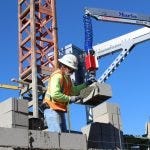Man Plus Machine Makes Heavy Work Easy
The MULE (material unit lift enhancer), from Construction Robotics, is a “cobotics” device, guided by the mason to clamp onto, lift, and position blocks or precast pieces including heavy 32-inch blocks.
October 8, 2020

Placing concrete masonry units is back-breaking work—that is unless the mason has a MULE to help. The MULE (material unit lift enhancer), from Construction Robotics, is a “cobotics” device, not a true autonomous robot but rather a very strong assistant that allows a mason to effortlessly place CMUs faster than is possible by hand. Mounted to the work platform, the MULE is guided by the mason to clamp onto, lift, and position blocks or precast pieces.
 �
� 
This device is beginning to gain a following in the masonry world. At a recent roundtable organized by the MULE’s manufacturer Construction Robotics, leaders from four general contractors discussed how they and their mason contractors are using the MULE and its effect on their operations.
The benefits such a device offer are clear: reducing the stress on the masons and allowing them to place more and heavier blocks in less time and with fewer people. Especially in the time of COVID-19, keeping workers farther apart is essential and the MULE contributes to that.
Tim Johnson, who leads Skanska’s operations in Portland, Oregon, noted that he is always looking for innovative ideas and the MULE has �“allowed us to be more productive and safer. Without the MULE, it takes two guys to lift the large 32-inch blocks we are placing today.”
The device has “given us the opportunity to rethink the size of materials and how they are maneuvered,” said Ryan Maibach, CEO of Barton Malow, Detroit. “And we are looking at other potential uses, like setting solar panels and structural steel.”
“The masonry industry hasn’t really changed since the pyramids,” said Andy Breuer, president of Hueber-Breuer Construction, Syracuse, NY. “We need to adapt to the labor shortage and younger guys are attracted to the idea of using innovative tools. It could save the trade.”
Tyler Shawcross, leading Clark Construction’s work at the new Washington, DC convention center, notes that the increased safety is important, as is increased productivity. “This reduces strained backs and pinched fingers. But it also makes the masonry work so much faster that removes it from the critical path especially since we are seeing so much more 32-inch block where the MULE becomes essential—it’s the only solution. When we are looking for partners in the trades, we want them to be innovative and something like this will single them out.”
Johnson notes that Skanska currently has eight MULES on their Portland project. “Once the masons see it working on site, it’s an easy sell. The guys don’t go home as tired.” But he recognizes that this new way of working is creating a need to organize the materials on the job a little differently. “Everything needs to be set up to feed the MULE, but it creates a cleaner, more organized job site.”
Maibach is very keen on the improvements in safety. “It’s hard to identify the injury that didn’t happen,” he notes, and agrees that there are a lot of potential applications yet to be explored. “We’re learning how to take advantage of this tool and it will be exciting to see how it’s uses will evolve.”
All agreed that training masons to set up, use, and maintain the MULE was reasonably simple and Construction Robotics has technicians available for any problems that arise. The return on investment seems favorable although even at breakeven the safety improvements would be more than worth the cost.
You May Also Like


